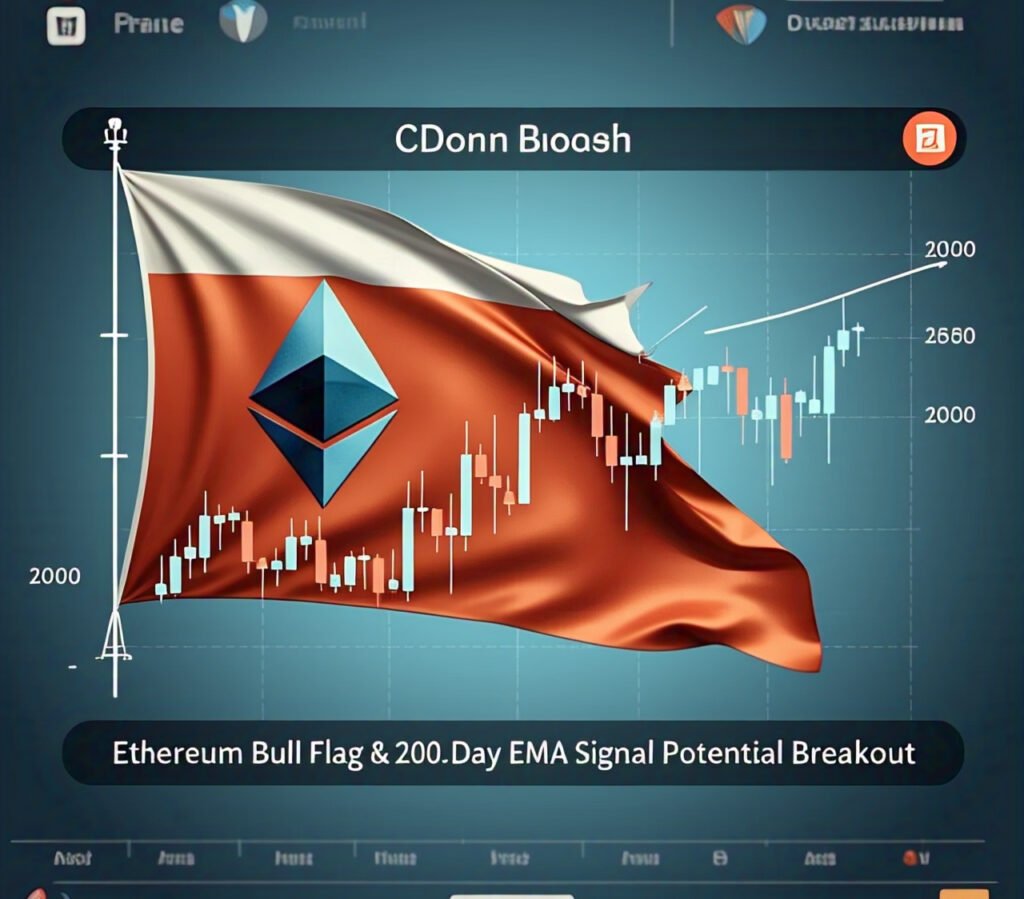Ethereum (ETH), the second-largest Cryptocurrency by Market capitalization, is forming a typical bull flag above its 200-day exponential moving average (EMA), displaying encouraging signals of a bullish breakthrough.
With experts considering the $3,577 mark as the next significant resistance level, this technical arrangement suggests a possible increasing price momentum. In this paper, we investigate Ethereum’s present market dynamics, the relevance of the 200-day EMA, the consequences of the bull flag development, and how these fit more general macroeconomic and crypto-specific trends.
Ethereum’s 200-Day EMA and Bull Flag Signal Market Momentum
Thanks partly to basic improvements and changing investor mood, Ethereum has shown substantial volatility in 2024. Respected by traders and experts, the 200-day EMA is a crucial benchmark of long-term market movements. A dip below signals a bearish phase; a price above this moving average suggests strong positive momentum.
 ETH has lately been consolidating above the 200-day EMA, creating a bull flag—a technical pattern defined by a strong upward movement (flagpole) followed by a period of consolidation in a limited downward or sideways channel. This pattern typically occurs before the continuation of the previous upswing and often leads to a significant price increase. This pattern’s formation on Ethereum’s daily chart suggests a fresh buying interest, maybe motivated by improved Ethereum ecosystem developments and favorable market conditions.
ETH has lately been consolidating above the 200-day EMA, creating a bull flag—a technical pattern defined by a strong upward movement (flagpole) followed by a period of consolidation in a limited downward or sideways channel. This pattern typically occurs before the continuation of the previous upswing and often leads to a significant price increase. This pattern’s formation on Ethereum’s daily chart suggests a fresh buying interest, maybe motivated by improved Ethereum ecosystem developments and favorable market conditions.
Ethereum Bull Flag Pattern Signals Potential Breakout
In technical analysis, traders often utilize classic continuation patterns known as bull flags to forecast possible breakouts. Regarding Ethereum, the session started with a strong surge that drove prices above critical resistance levels. The subsequent consolidation phase lets the market process gains and generate momentum for the next leg higher.
When this trend stays above a critical moving average, like the 200-day EMA, which acts as flexible support, it becomes more reliable; this combination of positive signs raises the chances of Ethereum reaching the $3,577 target. Market players sometimes see such confluences as validation points, driving more demand and trade activity.
Ethereum’s Growth: Innovation, Sustainability
Many fundamental and technical elements support Ethereum’s possible rise. With its Proof of Stake (PoS) consensus mechanism, the continuous Ethereum network migration to Ethereum 2.0 has lowered energy consumption and raised scalability. This improvement makes Ethereum more appealing to traders who care about the environment and institutional investors, fostering a good mood.
The decentralized finance (DeFi) and non-fungible token (NFT) industries built on Ethereum continue to thrive, driven by the high ETH “gas” fees and transaction charges within these ecosystems. Layer-2 scaling solutions—such as Optimism and Arbitrum—help to reduce network congestion even more, hence allowing faster and less expensive transactions that support more general adoption.
Macroeconomically, growing inflation worries and geopolitical uncertainty have pushed investors toward diversification into other assets, such as cryptocurrencies like Ethereum. As the class of digital assets develops, it becomes an increasingly significant barrier against the devaluation of fiat money, boosting purchase interest.
Ethereum Technical Indicators Signal Potential Bullish Breakout
Technical analysts looking at Ethereum’s price charts find numerous necessary signals bolstering the optimistic view. Apart from the EMA of 200 days, the Relative Strength Index (RSI) and Moving Average Convergence Divergence (MACD) offer insightful analysis of momentum and trend strength. The RSI is close to neutral levels, indicating plenty of upward movement space free from the early overbought region.
Furthermore, the MACD histogram shows indications of a bullish crossover, usually understood as a signal for possible trend reversals or the continuation of optimistic trends. These signals, combined with rising trade volumes during upward movements, support the case that Ethereum is ready for a breakout towards the $3,577 resistance.
Influences on Ethereum’s Price Bitcoin
Ethereum’s price behavior is sometimes associated with Bitcoin (BTC), the most prominent cryptocurrency and market leader. Bitcoin’s stability and comeback above essential moving averages provide a suitable habitat for altcoins such as Ethereum to flourish. Moreover, changes in global regulatory systems, including the U.S. Securities and Exchange Commission (SEC) clarifications on digital asset classifications and approvals of Bitcoin futures ETFs, indirectly affect Ethereum’s attitude and acceptance.

The extension of crypto offers from major financial players such as Fidelity, Grayscale, and Coinbase can explain the ongoing increase in institutional engagement. Their backing gives the market validity and liquidity, enabling Ethereum’s price increase. Furthermore, powerful people like Ethereum co-founder Vitalik Buterin are crucial in determining community confidence through technological innovation and thought leadership.
Risks and Challenges Impacting Ethereum’s Market Outlook
Investors should be wary of many hazards that can stop Ethereum’s path, even with the optimistic view. Volatile assets like cryptocurrencies naturally include bouts of market declines and profit-taking. A breach below the 200-day EMA or invalidation of the bull flag formation can set off a bearish attitude and downward pressure.
Adverse policy decisions or regulatory crackdowns might slow growth, especially if big economies ban distributed finance platforms or Crypto Exchanges. Technical issues such as network congestion or delays in Ethereum 2.0 upgrades can compromise investor confidence or user experience.
Global macroeconomic events, such as changes in risk tolerance or central banks’ interest rate hikes, could affect capital flows away from speculative assets. Therefore, traders and investors must pay close attention to these factors, in addition to technical cues, to make informed decisions.
Final thoughts
Examining papers on blockchain scalability, Ethereum 2.0 upgrades, and distributed finance solutions can help readers interested in broadening their knowledge of Ethereum and related subjects find essential background. Linking to credible bitcoin news sources like CoinDesk, The Block, and Messari can provide fast updates and professional analysis, enhancing the reading experience.
When debating macroeconomic effects on crypto markets, referencing reputable financial sources like Bloomberg, Reuters, and the World Economic Forum lends legitimacy. Including technical analysis and digital asset economics’ ideas in scholarly publications also helps increase topical relevance.

